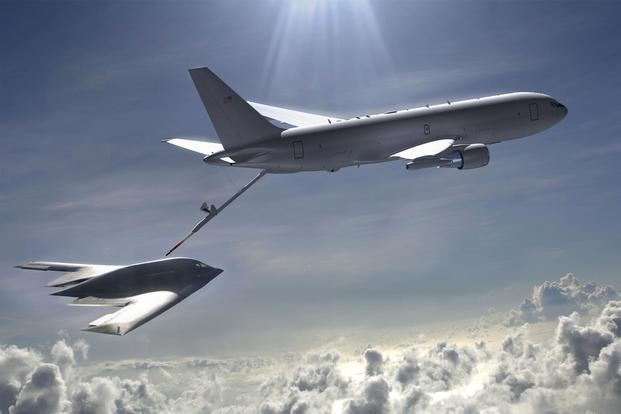The Air Force's newest tanker has been cleared to carry extra passengers and equipment following a three-month ban over faulty cargo locks within the aircraft.
The Air Force declared a critical deficiency impacting the KC-46 Pegasus closed Dec. 18, following "successful installation and testing of an improved cargo lock design," the service said in a statement Friday.
"The first KC-46A to receive the new hardware is assigned to McConnell Air Force Base, Kansas, and has resumed missions carrying cargo and passengers," the statement said. "The Air Force remains committed to holding Boeing accountable to fix deficiencies identified in both developmental and operational test and evaluation of the KC-46A's effectiveness, suitability, and mission capability."
Related: Air Force's Problem-Plagued New Tanker Likely Won't Deploy for 3 Years or More
In September, Defense News reported the Pegasus had been prohibited from carrying cargo or additional personnel until further notice because cargo locks -- which secure equipment into place within the aircraft -- had unlocked during a flight. It was listed as a "Category 1" deficiency, defined as a critical flaw that impacts the development, schedule and potentially safety of the aircraft.
"KC-46A integration represents an important step in recapitalizing our aging tanker fleet," said Dr. Will Roper, Assistant Secretary of the Air Force for Acquisition, Technology, and Logistics, in a statement on Friday. "While the program has not been without challenges, resolving this deficiency is a step in the right direction."
Boeing Co., the aircraft's manufacturer, said it has already retrofitted four tankers with the latest design.
"This milestone closes out the flight restrictions," Boeing said in a statement following the Air Force's announcement. "We continue to work closely with the Air Force to outfit all delivered aircraft with the new locks."
The KC-46 has had many issues, including problems with how the boom connects and disconnects from specific aircraft, issues with foreign object debris (FOD) -- or trash, tools, nuts and bolts found scattered inside aircraft -- and a glitch with the software inside the Remote Vision System.
The RVS permits the in-flight operator to view the refueling system below the tanker.
Currently, the glitch doesn't allow an airman to look at a clear, aligned visual of the boom connecting to another aircraft. The first tankers were delivered to the Air Force despite that problem.
Earlier this month, Roper told reporters the Air Force is weighing whether to implement a "laser-range finder" for refueling boom operators to better gauge the distance between the KC-46 and another aircraft during an in-flight refueling.
Boeing spearheaded the research. The laser-range finder wasn't included in the initial camera system design, Roper said, adding the efforts need additional work before potential development.
"We've got another turn before that design is tightened up to where we can proceed with it," Roper said at the annual Reagan National Defense Forum. "It is that kind of thinking that is going to get the RVS problem solved -- thinking outside the original design, which did not include that laser-range finder," he said, according to a report from Flightglobal.
Roper said Air Force engineers with the 711th Human Performance Wing at Wright-Patterson Air Force Base, Ohio, continue to test technology solutions and imagery overlays that could help Boeing fix the visual interface.
-- Oriana Pawlyk can be reached at oriana.pawlyk@military.com. Follow her on Twitter at @oriana0214.
Read More: US Troops May Be Overpaid, New Study Finds













